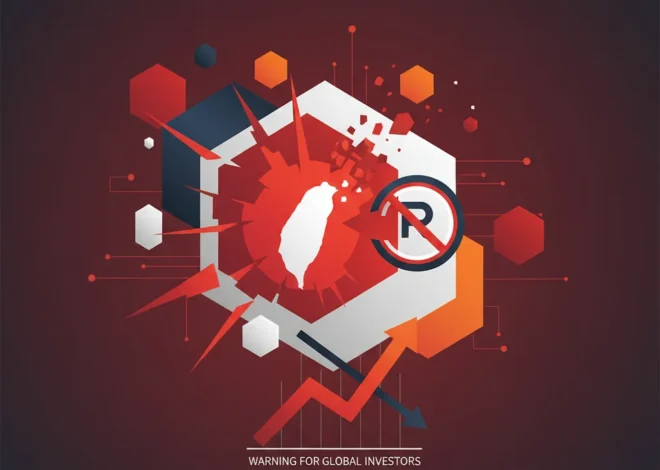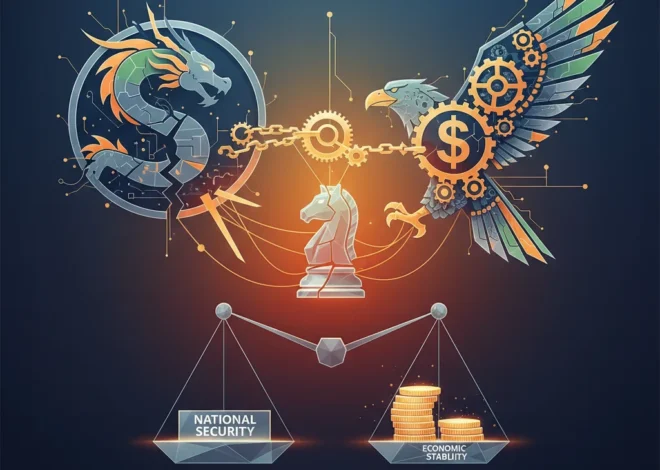
BHP’s American Copper Play: How a Potential Trump Presidency Could Resurrect Arizona’s Ghost Mines
A Tectonic Shift in the Global Commodities Landscape
In the world of high-stakes finance and global commodities, corporate leaders often speak in measured tones, their words carefully chosen to avoid unsettling the delicate balance of the stock market. That’s why when Mike Henry, the chief executive of the world’s largest mining company, BHP, openly states he is considering reopening defunct copper mines in the United States specifically in response to a potential political shift, investors, economists, and business leaders sit up and take notice. The announcement, reported by the Financial Times, that BHP is looking at restarting operations in Arizona is far more than a simple business calculation. It’s a seismic indicator of shifting geopolitical plates, a multi-billion dollar bet on the future of American industrial policy, and a crucial development in the global race for the metals that will power our future.
This potential move by BHP is a fascinating case study at the intersection of global economics, political strategy, and long-term investing. It signals a potential revival of American mining, driven not just by market demand, but by a powerful undercurrent of resource nationalism. For anyone involved in finance, from institutional investors to retail traders, understanding the implications of this decision is critical. It touches upon everything from commodity trading and supply chain security to the very structure of the future global economy.
Dr. Copper’s Diagnosis: A World Starved for a Critical Metal
To grasp the significance of BHP’s move, one must first understand the paramount importance of copper. Often nicknamed “Dr. Copper” by economists for its uncanny ability to predict the health of the global economy, this reddish-brown metal is the lifeblood of industrialization. Its high conductivity and durability make it essential for everything from electrical wiring in our homes to the intricate circuitry in our smartphones. However, its traditional roles are now being dwarfed by its critical importance in the green energy transition.
The global push towards decarbonization is, in essence, a push towards electrification. And electrification runs on copper. An electric vehicle (EV) contains, on average, three to four times more copper than its internal combustion engine counterpart. A single onshore wind turbine requires several tons of it. Upgrading national power grids to handle renewable energy and the surge in electricity demand will require astronomical amounts of copper wiring and components. This has led to a stark forecast from market analysts: the world is heading for a severe copper supply deficit. S&P Global predicts that global copper demand could nearly double to 50 million metric tons by 2035, creating a potential long-term shortfall of 10 million tons. This looming gap between supply and demand is setting the stage for a commodity supercycle, fundamentally altering the economics of mining.
Below is a breakdown of copper’s essential role in modern and future technologies, illustrating why securing a stable supply is a top priority for developed nations.
| Sector | Key Applications of Copper | Reason for High Demand |
|---|---|---|
| Green Energy | Wind turbines, solar panels, grid infrastructure, energy storage | Superior electrical and thermal conductivity is essential for efficient energy generation and transmission. |
| Electric Vehicles (EVs) | Battery components, electric motors, wiring, inverters | An EV uses up to 183 lbs of copper, compared to roughly 48 lbs in a traditional car. |
| Electronics & Telecom | Semiconductors, circuit boards, data centers, 5G infrastructure | High-speed data transfer and miniaturization rely on copper’s conductive properties. |
| Construction | Electrical wiring, plumbing, roofing | Durability, reliability, and established building codes ensure continued, stable demand. |
The Trump Factor: Reading the Political and Economic Tea Leaves
BHP’s consideration of reopening Arizona mines is explicitly linked to the potential return of Donald Trump to the White House. This isn’t just about personal preference; it’s a calculated response to the policies a second Trump administration would likely pursue. These policies could dramatically reshape the risk-reward equation for domestic mining projects.
A key pillar of Trump’s platform is an “America First” industrial policy, which often translates into tariffs on imported goods to protect and encourage domestic production. For a bulk commodity like copper, tariffs could make imported metal from traditional sources like Chile and Peru significantly more expensive, instantly making domestic production more economically viable. Furthermore, a Trump administration would almost certainly seek to streamline the notoriously long and complex permitting process for mining projects in the U.S. Environmental regulations, a major hurdle for new mining ventures, would likely face significant rollbacks, shortening the timeline from exploration to production and reducing upfront compliance costs.
This represents a profound shift in political risk assessment for a company like BHP. For decades, the primary risks in mining were geological (finding the ore) and financial (securing capital). Today, political and regulatory risks are paramount. By preemptively exploring a U.S.-based strategy, BHP is hedging against future trade wars and positioning itself to capitalize on a wave of deregulation, a move that could be a boon for its stock market valuation if it pays off.
Arizona’s Sleeping Giants: The Promise and Peril of Reopening Mines
Arizona, known as “The Copper State,” has a rich history of mining that powered America’s industrial revolution. However, many of these operations were shuttered over the past few decades due to declining ore grades, lower copper prices, and the high cost of complying with U.S. environmental and labor laws. Reopening these “ghost mines” is a monumental undertaking with a complex set of advantages and disadvantages.
On one hand, the geological data already exists. BHP knows where the copper is, which significantly de-risks the exploration phase. A domestic supply chain would be insulated from the geopolitical instability that can plague operations in South America or Africa. It would also create high-paying jobs in rural American communities, a clear political win. On the other hand, the challenges are immense. Legacy environmental issues from previous mining activities must be addressed. Water rights, a contentious issue in the arid Southwest, will be a major battle. Most importantly, the capital expenditure (CapEx) required to modernize and restart these facilities would be astronomical, requiring significant confidence in the long-term price of copper.
Investment banking would play a crucial role in structuring the financing for such a massive undertaking, while new financial technology could be deployed to manage risk and optimize trading strategies around the new production. Furthermore, there’s a growing demand for supply chain transparency, where technologies like blockchain could be used to track the copper from a U.S. mine to a U.S. manufacturer, certifying its origin and compliance with labor standards—a potential selling point for ESG-conscious consumers and investors.
Implications for the Broader Financial Ecosystem
BHP’s potential pivot has ripple effects that extend far beyond the mining sector, touching every corner of the financial world.
- Stock Market & Investing: For investors, this signals a potential re-evaluation of mining stocks, particularly those with U.S. assets. If BHP moves forward, it could trigger a rally in junior mining companies and exploration firms in North America. It also forces ESG (Environmental, Social, and Governance) investors to confront a difficult paradox: the very minerals needed for the green transition often come from an industry with a heavy environmental footprint. A U.S.-based mine, operating under stricter (even if streamlined) regulations, could be positioned as a more “ethical” source of copper.
- Commodity Trading: The prospect of new U.S. supply, even if years away, could introduce new dynamics into the copper futures market. Traders will be watching political developments in the U.S. as closely as they watch production reports from Chile. This adds a new layer of complexity to the global economics of the copper trade.
- The Global Economy: This is a clear example of “friend-shoring” and the broader trend of deglobalization. Nations are increasingly prioritizing supply chain resilience over pure cost efficiency. If the U.S. successfully ramps up domestic production of critical minerals like copper, it reduces its economic dependence on other nations, particularly geopolitical rivals like China, which currently dominates the processing of many industrial metals.
–
The Dawn of a New Era: Resource Nationalism Goes Global
BHP’s move is not happening in a vacuum. It is a reaction to and a part of a powerful global trend: resource nationalism. Around the world, countries are waking up to the strategic value of the minerals beneath their soil. Chile is tightening state control over its lithium reserves. Indonesia has banned the export of raw nickel ore to force the development of a domestic processing industry. Mexico has nationalized its lithium sector. This global power play over critical resources is the new geopolitical Great Game.
By exploring a U.S.-based strategy, BHP is wisely navigating this new reality. It is diversifying its political risk, ensuring it has a foothold in a stable, high-demand market that is actively seeking to onshore its supply chains. This strategic foresight is what separates a well-run global corporation from the rest, and it provides a valuable lesson for anyone involved in international business or finance: the political landscape is now as important as the geological one.
Conclusion: A Calculated Bet on an Uncertain Future
BHP’s consideration of reopening American copper mines is a landmark development. It is a direct corporate response to the shifting winds of American politics and a reflection of a world grappling with the immense resource demands of the energy transition. This is not merely a story about one company and a few old mines; it is about the dawning of a new era in the global economy, where supply chain security, national interest, and political alignment are becoming powerful drivers of capital investment.
For investors, economists, and business leaders, the message is clear. The game is changing. The intricate dance between politics, finance, and geology will determine who wins the race to power the 21st century. Whether BHP’s American bet pays off remains to be seen, but its willingness to make the wager has already sent a powerful signal that is reverberating through the entire stock market and the global economic order.


